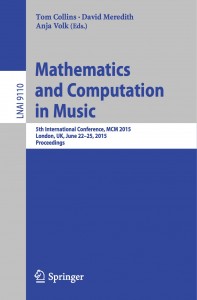
The papers presented at the conference are published in a volume, Mathematics and Computation in Music: 5th International Conference, MCM 2015, London, UK, June 22-25, 2015, Proceedings, which appears as Springer’s Lecture Notes in Artificial Intelligence 9110.
Access to the proceedings book is freely available for a four week period following the start of the conference. To access the papers, please go to http://link.springer.com/book/10.1007/978-3-319-20603-5.
Please find below the list of accepted papers.
LONG PAPERS with ORAL PRESENTATION
SCALES
- Emmanuel Amiot. Can a scale have 14 different generators?
- Marco Castrillón and Manuel Domínguez. On the step-patterns of generated scales that are not well-formed
- Thomas Noll. Triads as modes within scales as modes
PERFORMANCE
- Maria Mannone and Guerino Mazzola. Hypergestures in complex time: creative performance between symbolic and physical reality
- Matteo Balliauw, Dorien Herremans, Daniel Palhazi Cuervo and Kenneth Sörensen. Generating fingerings for polyphonic piano music with a tabu search algorithm
- Luwei Yang, Elaine Chew and Khalid Z. Rajab. Logistic modeling of note transitions
MUSIC GENERATION
- Jaime Arias, Myriam Desainte-Catherine, Carlos Olarte and Camilo Rueda. Foundations for reliable and flexible interactive multimedia scores
- Carlos Almada. Genetic algorithms based on the principles of Grundgestalt and developing variation
- Tsubasa Tanaka and Koichi Fujii. Describing global musical structures by integer programming on musical patterns
NOTATION AND REPRESENTATION
- Florent Jacquemard, Pierre Donat-Bouillud and Jean Bresson. A structural theory of rhythm notation based on tree representations and term rewriting
- Liang Chen, Rong Jin and Christopher Raphael. Renotation from optical music recognition
GEOMETRIC APPROACHES I
- Robert Peck. All-interval structures
- Tobias Schlemmer. Unifying tone system definitions: ordering chromas
- Alexandre Popoff, Moreno Andreatta and Andrée Ehresman. A categorical generalization of Klumpenhouwer networks
GEOMETRIC APPROACHES II
- Ozgur Izmirli. Constructing geometrical spaces from acoustical representations
- Clifton Callender. Geometry, iterated quantization, and filtered voice-leading spaces
- James Hughes. Using fundamental groups and groupoids of chord spaces to model voice leading
POST-TONAL MUSIC ANALYSIS (FOR HARMONY AND MELODY)
- Jason Yust. Applications of DFT to the theory of twentieth-century harmony
- Kate Sekula. Utilizing computer programming to analyze post-tonal music: contour analysis of four works for solo flute
PATTERNS
- Marcelo Enrique Rodriguez Lopez and Anja Volk. Location constraints for repetition-based segmentation of melodies
- Mathieu Giraud and Slawek Staworko. Modeling musical structure with parametric grammars
- Andrew J. Milne, David Bulger, Steffen A. Herff and William A. Sethares. Perfect balance: a novel principle for the construction of musical scales and meters
DEEP LEARNING
- Stefan Lattner, Maarten Grachten, Kat Agres and Carlos Eduardo Cancino Chacón. Probabilistic segmentation of musical sequences using restricted Boltzmann machines
- Bob Sturm, Corey Kereliuk and Jan Larsen. ?El Caballo Viejo? Latin genre recognition with deep learning and spectral periodicity
SHORT PAPERS with POSTER PRESENTATION
- Alexandre Popoff. A statistical approach to the large scale structure of John Cage’s Number Piece Five5
- Eita Nakamura and Shinji Takaki. Characteristics of polyphonic music style and Markov model of pitch-class intervals
- Rafael Valle and Adrian Freed. Symbolic music similarity using neuronal periodicity and dynamic programming
- David L Clampitt and Jennifer Shafer. Greek ethnic modal names vs. Alia musica’s nomenclature
- Masatoshi Hamanaka, Keiji Hirata and Satoshi Tojo. Structural similarity based on time-span sub-trees
- Robin Laney, Robert Samuels and Emilie Capulet. Cross entropy as a measure of musical contrast
- Raymond Whorley and Darrell Conklin. Improved iterative random walk for four-part harmonization
- Christopher White. A corpus-sensitive algorithm for automated tonal analysis
- Gilles Baroin and Hugues Seress. The Spinnen-Tonnetz: new musical dimensions in the 2D network for tonal music analysis.
- Dimos Makris, Maximos Kaliakatsos-Papakostas and Emilios Cambouropoulos. A probabilistic approach to determining bass voice leading in melodic harmonisation
- Brian Bemman and David Meredith. Exact cover problem in Milton Babbitt’s all-partition array
- Johanna Devaney. Evaluating singer consistency and uniqueness in vocal performances
- Katerina Kosta, Oscar F. Bandtlow and Elaine Chew. A change-point approach towards representing musical dynamics
- Ryan Groves. Finding optimal triadic transformational spaces with Dijkstra’s shortest path algorithm
DEMONSTRATION
- Gilles Baroin and Hugues Seress. From circle to hyperspheres, part III, exploring new mathemusical dimensions
